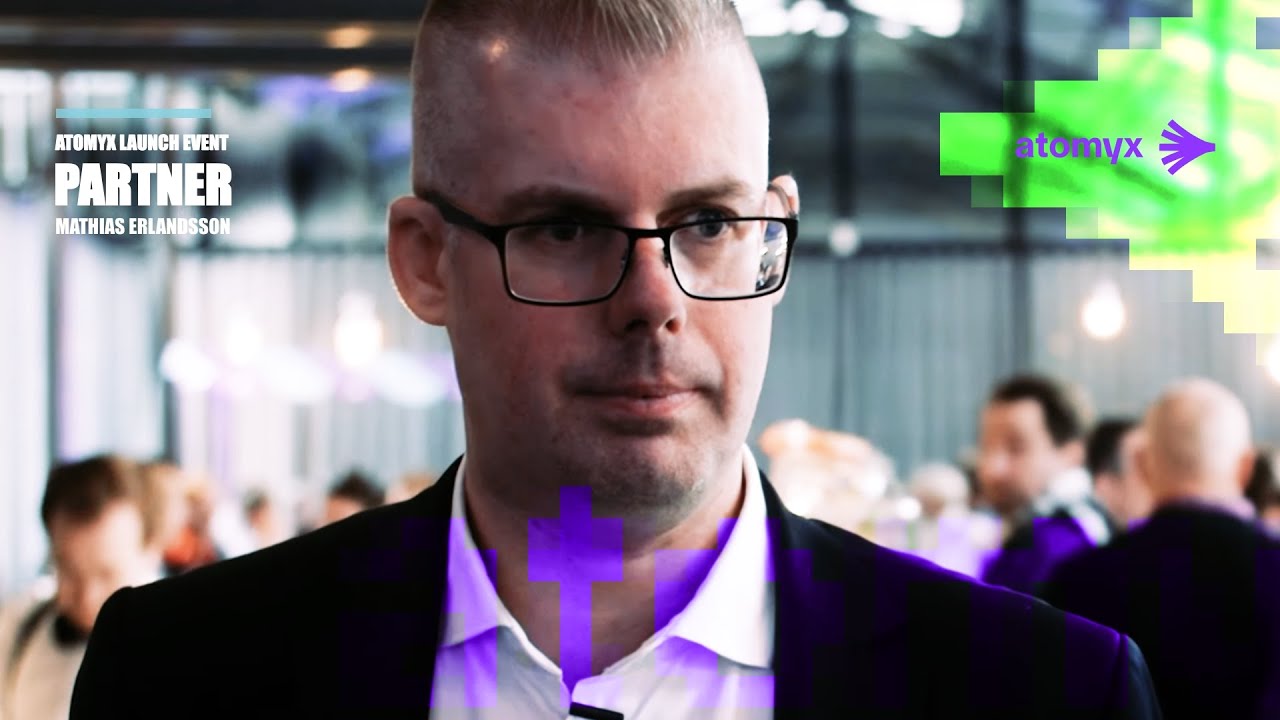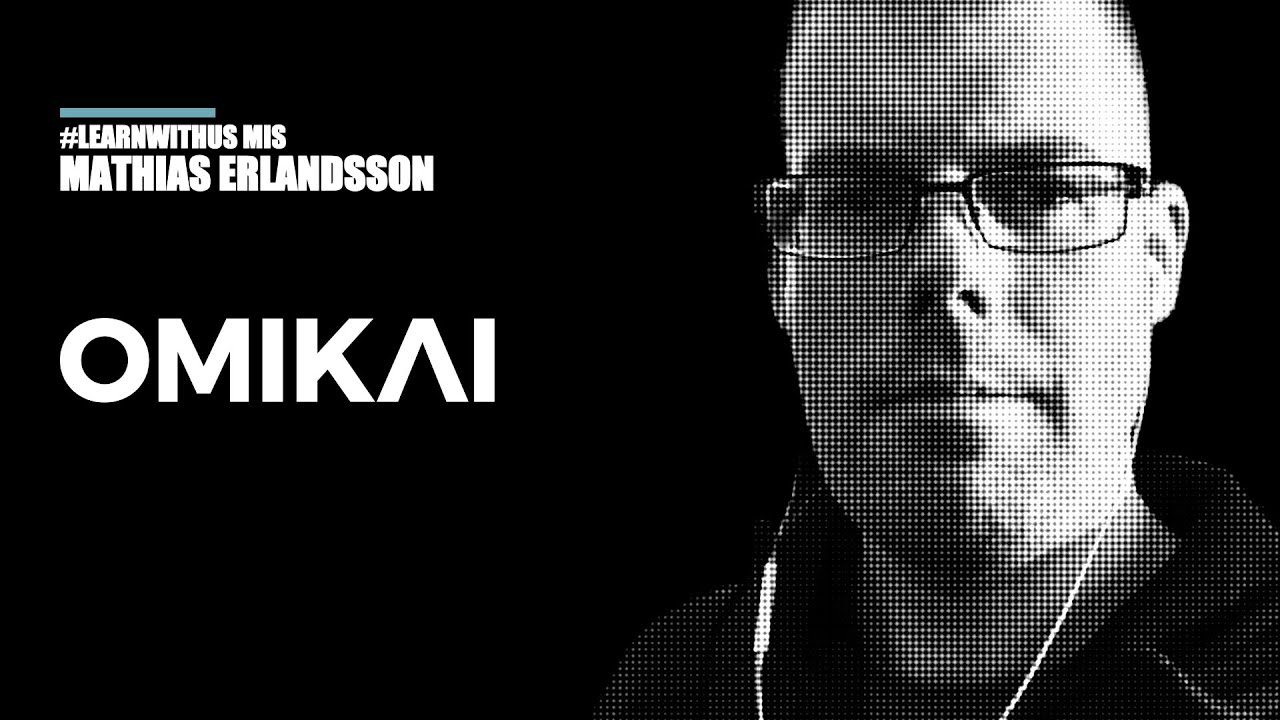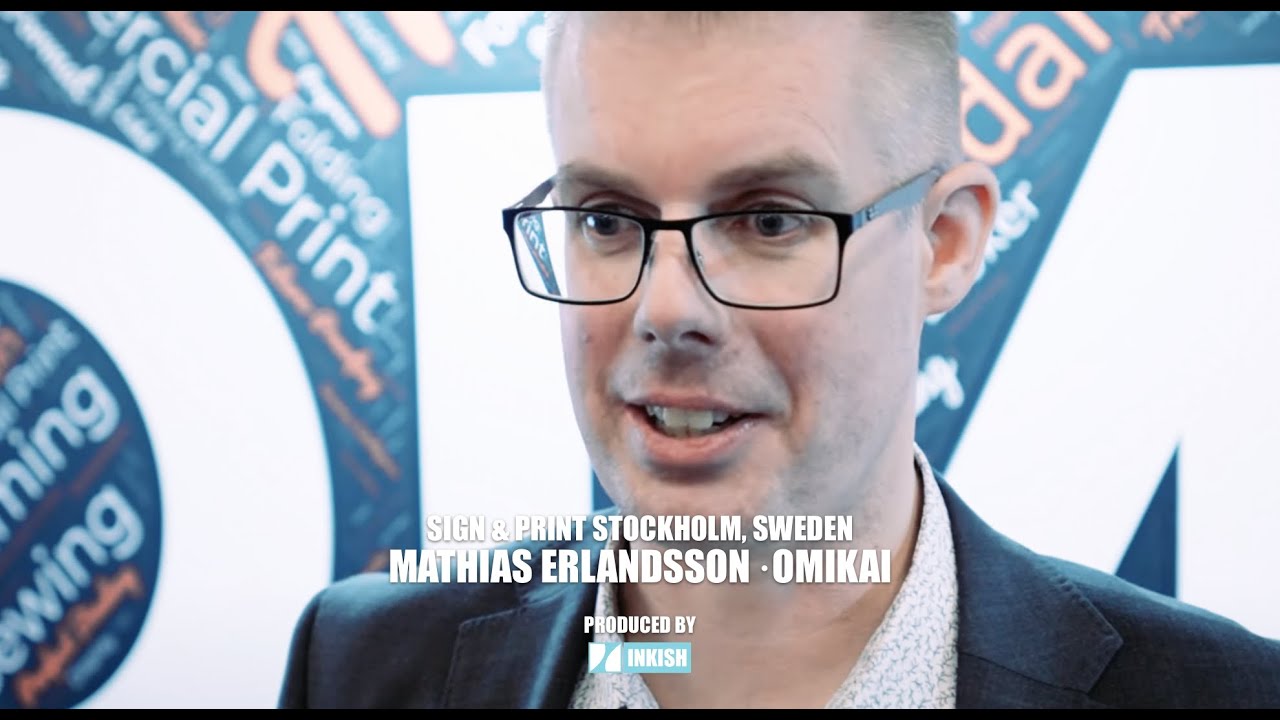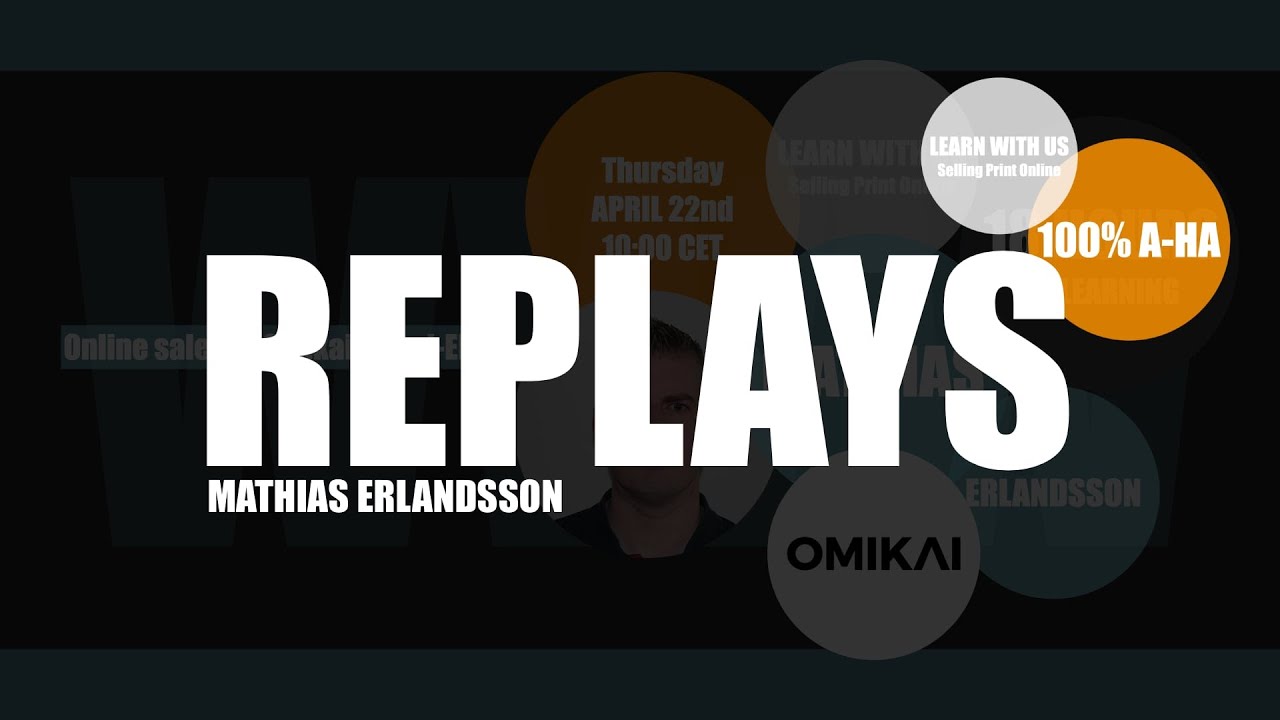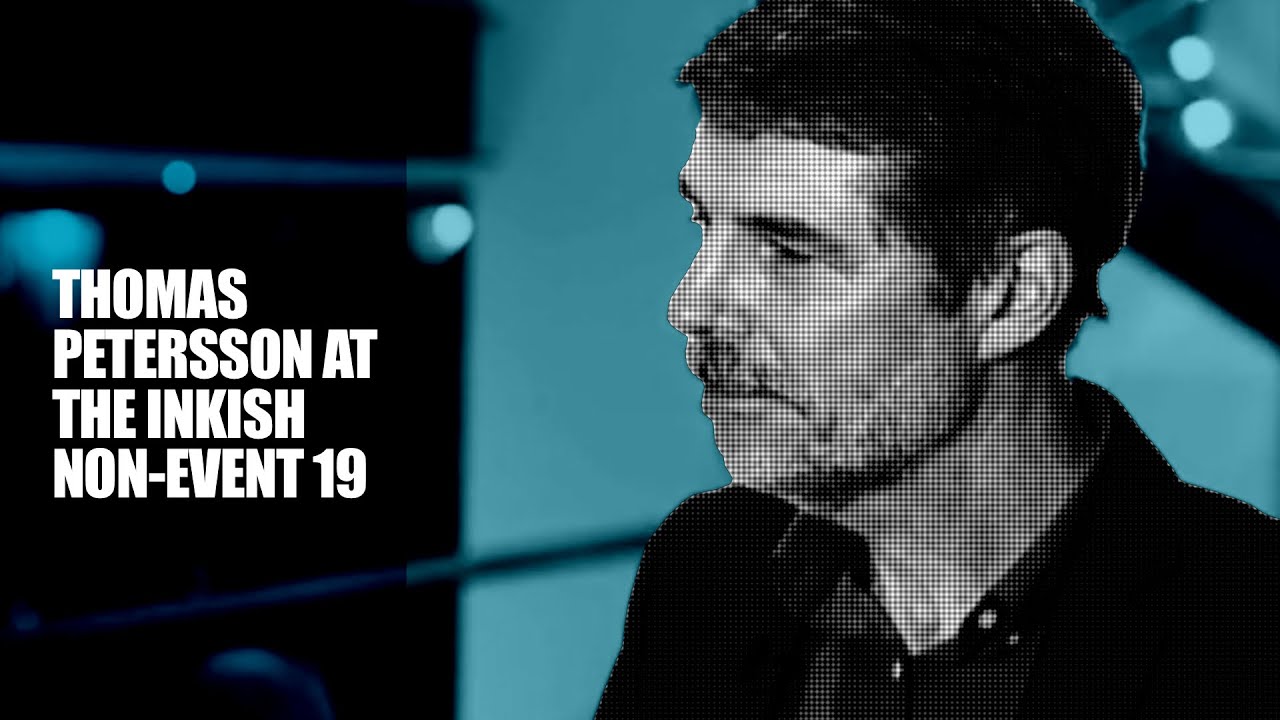Mathias Erlandsson · Over The Skype · OMIKAI
When we talk about the smart factory approach in the print sector, the starting point is a functioning ERP system that is specifically geared towards future requirements. State-of-the-art cloud technologies open up completely new perspectives, as Mathias Erlandsson, founder and CEO of Omikai Systems AB explains in an Over the Skye conversation with Andreas Weber, CEO INKISH D-A-CH.
“The requirements in Sweden are very similar to those in the DA-CH region“, explains Matthias. It depends on ease of use, transparency in all areas and a kind of omnichannel availability of the structured data that is dedicated to the needs of a successful and sustainable print business. It’s not only about production, but also management and administration, and above all about a much better go-to-market.
The most important thing is not to have to deal with technology any more, but rather to develop the right digital mindset: Open, flexible. thinking ahead, geared towards the context and collaboration.
The two conversation partners consequently open a dialogue that anyone interested can join.
—
Wenn wir über Smart Factory im Print-Sektor sprechen, so ist der Ausgangspunkt ein funktionierendes, ganz spezifisch auf zukünftige Anforderungen ausgerichtetes ERP-System. Hier ergeben sich durch zeitgemäße Cloud-Technologien ganz neue Perspektiven, wie Mathias Erlandsson, Gründer und CEO von Omikai Systems AB im Over the Skye-Gespräch mit Andreas Weber, CEO INKISH D-A-CH, erläutert.
„Die Anforderungen in Schweden sind denen in der D-A-CH-Region sehr ähnlich“, legt Matthias dar. Es komme auf Einfachheit bei der Nutzung, Transparenz in allen Bereichen und eine Art Omnichannel-Verfügbarkeit der strukturiert aufbereiteten Daten an, die beim Geschäft mit Print anfallen. Und das nicht nur in der Produktion, sondern auch in Management und Administration, und vor allem beim Go-to-Market.
Das Wichtigste sei nicht, sich noch mehr mit Technologie beschäftigen zu müssen, sondern den richtigen Digital Mindset zu entwickeln: Offen, flexibel, vorausdenkend, auf den Kontext und auf Kollaboration ausgerichtet.
Die beiden Gesprächspartner eröffnen folgerichtig einen Dialog, dem sich alle Interessierten anschließen können.
LinkedIn Profile: https://www.linkedin.com/in/mathias-erlandsson-aa780b15/
Hello dear friends of INKISH DACH. Today again an international conversation with a great, knowledgeable partner from Sweden. That’s why I’m going back to the English language. And we will subtitle everything so that nobody misses anything. Hello Mathias. How are you today? How is life in Sweden?
Hello Andreas. The weather is very fine here so I’m quite happy today. The sun is shining so everything is good. How is life in Germany?
So today we have cloudy weather. So maybe it’s not bad to talk to you as a cloud expert. Correct?
Maybe not.
And what is for me quite interesting is that you come from the let’s call it I.T. sector. But you fell in love with the printing industry. How could that relate? How did that happen?
Good question.
It’s more that we see a need for a digital transformation. A need for this automation. And its business and there has been a lot of change during the years. And I think now is the time to start talking about software and the digital transformation. And that’s why it’s very interesting for me that we come to this paradigm shift more or less.
That means your task is to support printing companies or a kind of printing companies. Commercial printers, as well as display printers, packaging printers. And why they could benefit from your ideas?
Definitely. We see ourselves as the catalyst for this change. And software is very important if you need to have a good fact based decision making. You need to have the intelligence from your business. And that you get more or less from ERP systems and software. They are very good to collect data. To structure data and present data for business owners and the one taking decisions.
That means you talk about software. I would say it’s more or less an architecture, a complete architecture, a solution. And this is something you deliver a kind of framework so that printers can do a better business in all dimensions. So not only the production processes. Also logistics, web-to-print and whatever. Maybe you can explain it a little bit. What is the value of a good cloud ERP system?
Yeah, definitely. The ERP is the heart of every business. You need to have good control over the entire order flow. Everything from getting the first customer contact to making quotes, orders. You talked about logistics and invoicing. But not only to keep control over that, but collect data so you can have a good knowledge about the business. What customers are profitable? What kind of products are good to deliver to the customers? What kind of machinery is more efficient? Those kind of fact based decisions you can get from the intelligence in an ERP.
So that is why it’s important for the entire business.
And what is your feeling? What do you think? Does the printing industry in total have already the right mindset for your approach? Because, you know, it’s not only about technology. You talk about data and amounts of data. And so security is important. Also trust. How is your experience? Because you are addressing right now the Nordic markets. Maybe you can tell a little bit? You can share your experience with us?
Yeah, we are addressing the Nordic market right now. But we are growing and we see a lot of the same situation all over Europe as in the Nordics. Companies are standing in front of the same situation and the same need for this transformation.
And I totally agree with you.
And the mindset, I think, yes and no, in many ways. I think that in theory, many companies know what to do. But they have very bad understanding of how to do it. I think we need to be more practical and more concrete. I think we need a lot more collaboration because many of these data is coming from not only software. But could also come from hardware. And I think that we need to do more collaboration among suppliers to get information from all levels to produce the kind of values that you need to bring to the market. The more collaboration, more communities, more partnerships – if necessary.
And what is the typical way you’ve got in touch with prospects? Do you have to give them a wake up call? Or do they already know they have a demand? You said they know that they have to do something. But they don’t know how. How are you approaching your prospects?
It’s transformation for us also. From the beginning, we were mostly contacting customers directly. Talking to them. And talking about the value of that kind of data that we can bring. And that kind of control it could bring. But we’re also going through a transformation where we are reaching out to the market, talking about this ideas that we have and this knowledge we have about how to do the digital transformation. And also starting out more and more partnerships. We have a partner network growing. With partners, both sales partners, integration partners and hardware suppliers. And I think that doing this kind of networking collaboration is a way of reaching the customer with combined solutions. Because that is the thing that you need to have more and more in the future to bring this kind of value.
That’s a good point. And I think printers, they love to talk about their hardware and maybe they’ll love to talk about their production workflow. But in my opinion, this cloud ERP approach is not a topic which gets treated in the public. And on top, the market is very fragmented. So we stopped at INKISH to count when we reach 200 different ERP solution providers around the globe. So I think success stories are important. Are you able to to share your success?
Are customers open to that?
Yeah, definitely. I think that most of our customers are very open to share testimonials and success stories. Because I think that it’s a community among print service providers that you share a lot of ideas. Even though you are competitors, you are very good understanding that we need to work together to bring the entire industry forward. So I think for us it’s been very, very easy to get information to spread to the world about what we have done. And what we have succeeded in. So, yes. And we’re getting more and more active also talking and marketing and informing the market about those kind of things.
Yeah, I was happy when I saw a couple of days ago that my colleague Morten published on INKISH TV an interesting case study. It’s about one of your customers. Tello Gruppen. And I was really fascinated when I was reading that you with your company OMIKAI, are something like a growth enabler for them. I would not have expected that that you could enable growth. Maybe you can share some insights out of that Tello Gruppen interview.
Yeah, it’s one of our first customers. We’ve been working very close together with them. And they have gone through a lot of changes in their business. They have merged with other companies. And they have been doing a generational shift. So they are very driven to improve their business. And also seeing that – we talked about it before, that you saw it was two hundred ERPs or more less – there are a lot of ERP systems, a lot of hardware suppliers, a lot of individual things brought to the market. But I think that what we need to see more in the future is complete solutions.
And that is what we have worked quite a lot with, with Tello Gruppen. And I think that is what the entire business needs. Not only individual things, because if you want to bring this kind of joint values. If you’re talking about Industry 4.0. Then you need to bring complete solutions to the market. And that’s what we have been doing there and will continue to do, because I think that is what you need. To take this market to the next phase.
And when I got it right, Tello Gruppen is not based on a single place. They have different, I think, five facilities around Sweden. And it was also your job to connect all those different production places. What was the biggest challenge in doing that?
I think the challenge or the benefit of working with cloud ERP solutions is that you can be not based on one location. So you can be spread all over Sweden in this situation. But all over the world, because you can have good insights in what’s happening in your production sites. Because you have these remote ways of connecting. You can work with doing quotes, whatever you want.
You can share data with other colleagues wherever they are. Nowadays in the Corona times, people are working more from home. And that is also very possible to do with the cloud ERP solutions. So I think that wherever you are and whatever situation you are in, you can still benefit of having one solution to cover the entire company. Even though it’s split to many sites.
That means you a customer of you or a user of your solution…He does not have to run a certain app. It’s a browser based approach?
Yes it’s correct. It’s a browser solution. It can run it in the browser. And I think that is how it should be also. So don’t need to have any special plug-ins or specific browsers. You can run it from any device and any browser. Just to connect. And also the benefit of cloud is that you don’t need to have any servers. You don’t have any I.T. administration. It’s totally a worry free IP. Because we take care of everything. And the employees can totally focus on their business and bring a value to the business – by working.
That means that is not a big job to do to use your system. And this is always a question when you make the decision, for example, to create or to set up a partnership with you and OMIKAI. So how long does it take? And I think we have two different aspects. One is a customer who has no ERP system. On the other hand, I think there are some who have the let’s call it the old generation of ERP systems. Could you please share your experience about this approach? And how long does it take and what effort a customer of you has to do?
You said it’s a difference between small companies and larger companies. Larger companies understand that this is not an IP product and that is very important to focus on. They understand that this is a change management project. They need to bring the organization and the processes and the different different roles in the company up to date. And also have the opportunity to change that when they are presented with a new system. The companies that understand that it is only to bring in the new system and everything will be good, they will have the problem. And I think that we need to have that mindset together. And that is why it’s often more easier with companies that have that understanding.
But if you’re talking about time – we can set up in a new customer in a couple of days, it’s normal. Nothing more than that. Included migration of all data, including doing basic configuration. The thing that takes time is to bring this to the organization and to map the different processes that you need to maybe change or evolve when you’re presented in your system. So but normally we talk about a couple, two or three months to bring a new system up and running. Normally.
And how is the impact on the installed hardware base your customer is running? Does that matter if it’s a system from a supplier A or B or C?
That doesn’t matter. We have a generic migration tool so we can migrate data from older systems if it’s possible to export it, of course, in some way to our new system. And I think that is very important to do. Because you have to know a lot of repeat orders. You have a customer register that you have built up during the years. And it’s a very important knowledge there. So that kind of data, it’s very important to get into the new platform and that we can help with.
And I think that is the game changer also to try to make a good ERP and installation good, successful and profitable.
That sounds good. And maybe going a little bit back in your history, which is….you know, you are a young company. I think you started in 2015 and then. Did you get your first customer on the fly? And was it a big investment for you to get the business started? Or does it have a very smooth, smart go to market scenario?
When we started the company the year before even. But we had our first customer in 2015. And yeah, the first customers was quite easy to get because there are always early adopters. Companies that are very open to new ideas and new solutions. So we rather soon got a customer base to work with. And also before we started to sell the system, we formed what we called a peer group. Or a group of customers that we were talking to and more or less developed the system together with them. So everything started with an idea. It started with me coming from a history, working with the digitalization and automatisation in other businesses. But bringing this to the printing industry. And that idea we talked about and discussed among the group, saw all obstacles. Found out what we should focus on and formed the system. And this group was the first users of the system also. And it grew organically from there.
Yes, that sounds good. But you have told me already when we had a discussion – a couple of discussions before – that you also want to put in quotes ‘escape from the Nordic market’ also to to the DACH region. Why is Germany, Austria, Switzerland – why is that interesting for you? Or is it a challenge?
It’s both I think. Every new market you enter is both a possibility, but also a challenge. You can be naive and think that everything is the same in Germany as it is in Sweden. And on the surface it is. But if you dig deeper, you can see a lot of differences. Yes. But the problem is the same. I think the thing that companies are going through is the same for every company. No matter if it’s in DACH or if it’s in the Nordics or US or whatever. You still stand before this thing digital transformation where you need to do this shift to be profitable and efficient in the future.
So but of course, DACH is a bigger market than the Nordics and we need to spread and we need to have a bigger market to focus on. So it’s natural to grow and I don’t think that every company wants to grow either. But we have the driving force to do that. And we are very willing to spread over Europe and first DACH especially. To help this market and be the catalyst for this transformation. There, too.
So you don’t have any language problems? Because your system can provide any language, I think. And especially in the DACH region, people are maybe more skeptical than in other parts of the world. So and everybody here, especially in Germany. They think: Oh, what Mathias is doing, it’s so disruptive. How could you convince those people that they have no risk in stepping in to your world of thinking and acting?
Yeah, I think that a lot of pros are going for this cloud ERP solutions. We talked about the word VIP – that you don’t have to care about those kind of things. I think also very good point is that by having this continuous development that we have, because the benefit of having cloud ERP is that we can deliver a new functionality almost every week. Coming new things.
And I think that to be a company and to be up to date with the most modern technology and having the best possibilities, then you have to have a cloud ERP supplier. So you can have the cloud ERP as a heart in the industry and always lets us keep that up to date. And the best as it could be.
An important point in my region is always: When we get in partnership with you – is it sure that we can do a much better business than before? And in my opinion, because I screened OMNIKAI, I saw a lot of your presentations. I went to your website and I found it very well structured for me, very logical. So but the question is still in advance. Could you. Could you guarantee a better go-to-market? And if so, how are you doing that?
I can guarantee a good go-to-market because we have this history. We wouldn’t go to the DACH region and to Europe without having done this many times in the Nordics. I think that we have been controlling our growth very much and not getting out in Europe until we are ready for it. So I think we have the best practices on how to do onboarding. We have a system that we know is configurable to handle all kinds of production. So we are a very safe in the situation we are in right now. And I think Swedes and Germans in some ways are alike there. That we don’t want to do anything until we have good control over that. And that we have a good quality. And good insurance, that we can bring this to the market in a good fashion. So now we are ready more than ever. And that is because we have proven ourselves during the history.
It sounds very good and what I discovered and I was really astonished that, by the way, in quotes, you can also offer very specific web-to-print shops coming out of all those data you are collecting and structuring. Is that is that a very useful option for customers? Or do they do that like that as I like it?
They love it because to have that same solution. It’s very, very important. You have had a history with legacy ERP systems and specific web-to-print systems. Doing very good individually. But the problem has always been to integrate them. And if you integrate them usually the integration you do is that the web-to-print orders are registered in the ERP. But that’s it.
And you still have to do the same CRM and customer data in both systems. You need to handle articles in both system. Prices in both systems. But if you have everything combined in one solution, I think that is necessary to have the full potential of the combined solution. Because in OMNIKAI we can have this product templates that you can calculate internally with. But you can also buy a single push of a button and publish it on the store front. But easier for the customer to buy it also. And I think you need to have data on one place but be able to channel orders from many places in many, many situations.
That means when I got it right. I saw the benefits of your cloud ERP system approach – it’s easy to use on any platform. So it’s not a big learning to step in. It’s very transparent. And so it’s not a secret. But maybe that the hidden beauty of it, it’s something like a single source system approach with multiple outcomes. Yeah, is that right?
Yeah, it’s a single source with the data in one place. But you can control the data and work with that from many places. Yes. But also you have to touch the point. They’re talking about what kind of cloud ERPs that could be because our idea is a multitenant cloud ERP. It means that we have one platform serving all the customers we have. The other approach is to take the service from the customer and take care of it ourselves. But then it’s still going to be different installations to each customer. And that is not the true ERP solution. So for us, the true ERP solution is multitenant. That we have data on one place and one platform serving every customer. And also you talked about that, that the integrations and that transparency also benefits of cloud solutions. That you can have more openness to the outside world with our APIs. So it’s very much easier to bring integrations to market. Integrations with other systems but also integrations with machinery. And then it’s getting more and more interesting because if it gets that integrations, you bring machine data to the system also. You have a lot of good intelligence in that big data so you can have even more value bringing to the market than to the customers.
So I think that the disruptive momentum in cloud ERP is not that it’s not a technology disruption, it’s more or less dedicated to the fact that your customer could reinvent what they do. And they can optimize it. And what kind of people you need as a peer group, as bodies inside those customer companies. Is it the top down approach or do they need really I.T. skills to understand what you do?
No, it’s not about technology knowledge at all, it’s all about mindset, it’s all about that you see possibilities. That these combined solutions can bring to the market. And they are very open for new ideas. They are early adopters of adopting a new mindset and they are very open to working together with suppliers in sharing ideas and giving feedback. Something that is more important than having knowledge. Because we have the knowledge. They are the market. And they need to give us feedback and listen to our ideas to form the new era after this big transformation has been successful.
And I think for customers, it’s also a benefit that when everything is established and when they start your collaboration and working with you, then he is also in a situation to use this as a good argument to sharpen his profile. And to talk with his customers about the beauty and the new kind of business he’s doing. Do your customers do that already?
In some way. As I said in the beginning, I think that many customers talk with their former supplier individually and talk with a software supplier individually. And the suppliers are listening to the customers and seeing the need for new values to bring to the market. But they cannot do that by themselves because it will require something from another supplier. I think that all this community, all this networking idea brings all this needs to the same table. And we can sit down and we can discuss what kind of synergies we can find if we’re working together and finding solutions together.
And that is, I think, the the approach that the market is needing and requiring to be successful.
Yes.
Cool. So I think we have we have now almost 30 minutes of talking. Time is running. So so interesting. And I think it’s not the last time we have such a good conversation. Maybe my final question is – Steve Jobs always said: What’s next? And what is on your agenda for the next three or six months?
If you want to talk about it.
Yeah, for me, we have the ideas of how to go forward. So I think the next step is to form these alliances and form these groups. And we need to find the the other hardware suppliers that are interested in participating in making this digital transformation from theory to practice. And I think we need to find the customers that are open to participate and we need to form this kind of peer groups and these discussions. So we are already talking to a lot of companies about this.
But I think that in the three to six months coming, we need to form this and also depending on Covid meet and to try to find the forums to take this further.
Yes, so then maybe it’s not a bad idea if we also collaborate. You said collaboration is so important and what I can offer with INKISH DACH is to create such a platform of knowledge exchange. And maybe the end of the year period is a good time to try to work on that approach, because I think the demand is huge. And also it’s important to get in touch with people like you. Because I think, Mathias, you have already the right mindshift.
Hopefully. As we see it yes. But I’m always open to new ideas and other ways of doing things. But I have a clear understanding of what to do. And I think that you said it yourself. INKISH has a very important role over here also to talk about this, to spread the understanding about… You already talked a lot about Industry 4.0 and the Smart Factory. Very, very important is to spread that knowledge and to get the markets understanding of how important this is. So we will continue and talk about this. And forming these alliances and the forums. It’s very important.
OK, then, thank you very much for the great conversation. And NIKE would say: Just do it. Correct? So, Mathias, stay safe in Sweden. Many thanks for your time. And we continue to share our passion for all this digital mindsets and the things we talk about. So have a great day.
Thank you to you, too. And have a nice day you, too. And keep in touch Andreas. Bye.
Yeah, we do so.
Bye bye. Take care.
Bye bye.

































































